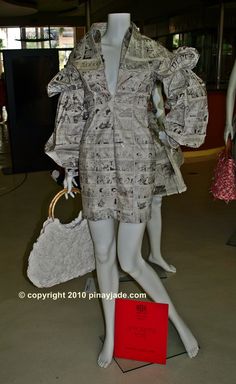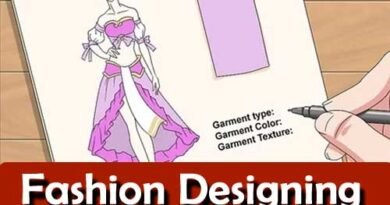Ready a Dress with Newspaper
Crafting a dress with newspaper involves blending creativity with unconventional materials to create unique and expressive fashion statements. This class note delves into the art of using newspaper in fashion design, exploring its historical context, practical techniques, creative possibilities, and educational value within the realm of craft and fabric manipulation.
Historical Context and Inspiration

The concept of using unconventional materials in fashion design dates back centuries, often driven by necessity, innovation, or artistic expression. During times of scarcity or economic hardship, designers and individuals have turned to alternative materials to create clothing and accessories. Newspaper, with its readily available and lightweight properties, has emerged as a versatile medium for crafting garments that defy traditional notions of fashion.
Early Examples:
- World War Era: In periods of rationing during World War I and World War II, newspapers were repurposed for various household needs, including makeshift clothing and accessories.
- Avant-garde and Art Movements: Artists and designers associated with avant-garde movements, such as Dadaism and Surrealism, experimented with unconventional materials to challenge established norms and provoke thought.
Techniques and Process
Crafting a dress with newspaper involves several key techniques and considerations to achieve a wearable and aesthetically pleasing garment:
- Selection of Materials: Choose newspapers with different textures, colors, and sizes. Consider the content of the newspaper as it can add thematic or visual interest to the design.
- Preparing the Newspaper: Treat the newspaper to enhance durability and manipulate its properties. Techniques may include stiffening with glue or varnish, crumpling to create texture, or layering for strength.
- Pattern Making: Develop a basic pattern or template based on the desired silhouette and structure of the dress. Adjustments may be needed during the fitting process to ensure a proper fit and comfort.
- Construction and Assembly: Use techniques such as folding, pleating, twisting, and weaving to manipulate the newspaper into desired shapes and forms. Secure layers and seams with adhesive, stitching, or other suitable methods.
- Finishing Touches: Add embellishments, trimmings, or decorative elements to enhance the visual appeal and craftsmanship of the dress. Consider integrating other materials like fabric, beads, or metal accents for contrast and texture.
Practical Considerations

Crafting a dress with newspaper presents both creative opportunities and practical challenges that designers and artisans must navigate:
- Durability and Wearability: While newspaper can be treated to increase durability, its inherent fragility requires careful handling and maintenance to ensure longevity. Consider the intended use and lifespan of the garment.
- Comfort and Fit: Pay attention to comfort and fit during the design and construction process. Newspaper, despite its lightweight nature, can add bulk or stiffness depending on the techniques and treatments used.
- Environmental Impact: Explore sustainable practices by repurposing newspapers or using eco-friendly treatments and adhesives. Consider the recyclability or biodegradability of materials used in the design.
- Legal and Ethical Considerations: Be mindful of copyright and intellectual property rights when using newspaper content as part of the design. Respect ethical guidelines regarding the use of materials and their cultural or historical significance.
Creative Possibilities and Expressive Potential
Crafting a dress with newspaper offers limitless creative possibilities for designers and artisans:
- Artistic Freedom: Experiment with shapes, textures, and forms that transcend traditional fabric constraints. Newspaper allows for innovative designs that challenge conventional aesthetics and provoke thought.
- Theme and Narrative: Use newspaper content to convey a specific theme, message, or narrative within the design. Explore socio-political commentary, historical references, or personal storytelling through visual elements.
- Texture and Surface Design: Manipulate newspaper to create unique textures, patterns, and surface treatments. Combine different folding techniques, layering methods, and finishing touches to achieve tactile and visual interest.
- Mixed Media Integration: Combine newspaper with other materials such as fabric scraps, metals, plastics, or natural fibers to enrich the design palette and enhance structural integrity.
- Fashion as Art: Elevate fashion design to the realm of wearable art by pushing boundaries with unconventional materials and experimental techniques. Challenge perceptions of beauty, functionality, and materiality in fashion.
Educational Value and Learning Outcomes

Crafting a dress with newspaper serves as a valuable educational exercise for aspiring fashion designers and students:
- Material Exploration: Develop an understanding of material properties, manipulation techniques, and the transformative potential of unconventional materials in fashion design.
- Technical Skills: Hone skills in pattern making, garment construction, and craftsmanship through hands-on experimentation with newspaper as a medium.
- Creativity and Innovation: Foster creative thinking, problem-solving, and innovation by exploring non-traditional approaches to garment design and construction.
- Environmental Awareness: Promote sustainability awareness by exploring repurposing and upcycling techniques using newspaper and other recyclable materials.
- Concept Development: Use newspaper as a medium for exploring themes, concepts, and personal expressions within fashion design. Develop a cohesive design narrative that integrates visual, conceptual, and technical elements.
Contemporary Applications and Trends
In contemporary fashion, designers continue to explore the potential of unconventional materials, including newspaper, as a means of sustainable innovation and creative expression:
- Upcycling and Sustainable Fashion: Embrace the principles of sustainable fashion by repurposing materials and minimizing waste. Newspaper dresses exemplify eco-conscious design practices that prioritize resourcefulness and environmental stewardship.
- Fashion Activism: Use newspaper garments to raise awareness about social, political, and environmental issues. Incorporate headlines, images, or text that provoke dialogue and advocate for positive change.
- Cultural Commentary: Explore cultural identity, heritage, and globalization through the juxtaposition of newspaper content and fashion design. Consider how media influences perceptions of fashion, beauty ideals, and societal norms.
- Collaborative Projects: Engage in interdisciplinary collaborations with artists, journalists, activists, and community members to co-create newspaper fashion pieces that transcend boundaries and foster dialogue.
- Fashion Shows and Exhibitions: Showcase newspaper dresses in fashion shows, exhibitions, and public installations to spark curiosity, inspire creativity, and challenge preconceptions about materiality and fashion.
Conclusion

Crafting a dress with newspaper exemplifies the intersection of creativity, craftsmanship, and sustainability in fashion design. From its historical roots as a response to economic and creative constraints to its contemporary applications as a form of artistic expression and social commentary, newspaper dresses challenge conventions and inspire innovation.
For fashion designers and students, experimenting with unconventional materials like newspaper offers an opportunity to push boundaries, explore new techniques, and redefine the possibilities of fashion as both an art form and a medium for storytelling. As the fashion industry evolves, the use of newspaper and other non-traditional materials will continue to inspire designers to rethink fashion’s impact, purpose, and potential in a rapidly changing world.
